How I Do It: Classroom CORE Book by Tabi Jones-Wohleber
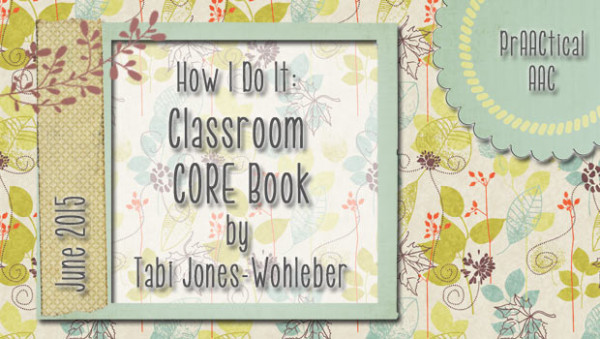
Although summer is just beginning, many SLPs in our region are already thinking about the next school year. If you are trying to increase classroom use of AAC, you will want to check out the core vocabulary resources developed by Tabi Jones-Wohleber. Tabi is a Maryland-based SLP who works on the Frederick County Public Schools AT Team. You can view her earlier post (and accompanying downloads) here. In this post, Tabi shares her wonderful Communication Opportunities Ready to Engineer (CORE) book and explains how she uses these materials.
Tabi Jones-Wohleber. Tabi is a Maryland-based SLP who works on the Frederick County Public Schools AT Team. You can view her earlier post (and accompanying downloads) here. In this post, Tabi shares her wonderful Communication Opportunities Ready to Engineer (CORE) book and explains how she uses these materials.
:::::::::::::::::::::::::::::::::::::::::::::::::::::::::::::::::::::::::::::::::
Classroom CORE (Communication Opportunities Ready to Engineer) Book:
When posed with the question “How can I use core more?” by a group of teachers inspired to make communication a priority, I was thrilled to be part of a team motivated to investigate this exciting question. These talented Rock Creek School educators teach a diverse population of students with all manner of physical, intellectual, and sensory disabilities, most of whom use AAC in one form or another. And because improving communication has been a focus at RCS for several years they understand the importance of incorporating core vocabulary throughout students’ school day. But still, it isn’t always easy. It isn’t always easy to pull all the pieces together: the modeling, the repetition, the varied opportunities. What we learned from one another as we fleshed out the question of “more core”, was that logistics are seldom easy, staff often change and have different priorities and areas of expertise, and no one ever has never enough time to prepare the way they would like. Faced with these challenges, the Classroom CORE (Communication Opportunities Ready to Engineer) book evolved as a versatile tool for teachers to quickly, consistently and tangibly identify the core vocabulary being targeted in a lesson, and manipulate it to address the needs of diverse learners. Essentially, this 2-binder toolkit is:
1. 2 banks of moveable core vocabulary symbols (small and large), color-coded by parts of speech per the modified Fitzgerald key. The storage pages are printed with the symbols as well on corresponding color paper, so you always know where the symbol goes, and can quickly identify if vocabulary is missing.
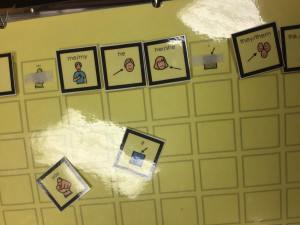
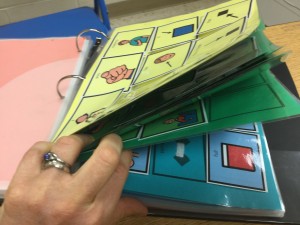
2. A presentation tool in 2 forms: a Flexible CORE Communication Board, (INSERT PHOTO:FlexCORE) and a Black Board (aka: black binder with black Velcro for arranging vocabulary).

Teacher’s Toolkit:
Before going into detail about how these pieces work together, I need to emphasize that this is a teaching tool, and is not intended to replace communication devices, especially for students using robust communication tools. Device selection for students is a decidedly more complex and careful task, and this tool should not be seen as a replacement for that process. However, as a teaching tool its many purposes include:
- bringing focus to the language being used during a lesson or activity.
- modeling the language of pictures by combining/sequencing pictures to create and extend meaning.
- informing classroom staff (in the moment) of the vocabulary to be used during a lesson/activity, to help them support students by engaging with them and their devices using the targeted vocabulary.
- providing visual supports that can be used with simple communication devices or displays for students who are not/not yet using generative AAC tools with built-in core vocabulary.
Flexible CORE Board & small symbols: The example shown below relates to a lesson about Wetlands from www.pebblego.com. Language of the Lesson included:
- Wetlands are wet (and) low.
- Wetlands hold water; Wetlands same (as) sponge.
- Grasses, water lilies, cattails grow.
- Snakes, birds, bugs live.
The Flexible CORE Communication Board contains high-frequency core vocabulary across the top half of the board (static vocabulary), with empty cells to expand the language of the lesson with additional small core vocabulary symbols (dynamic vocabulary) relevant to the activity. In essence, an engineered topic board easily customized with minimal pre-planning. 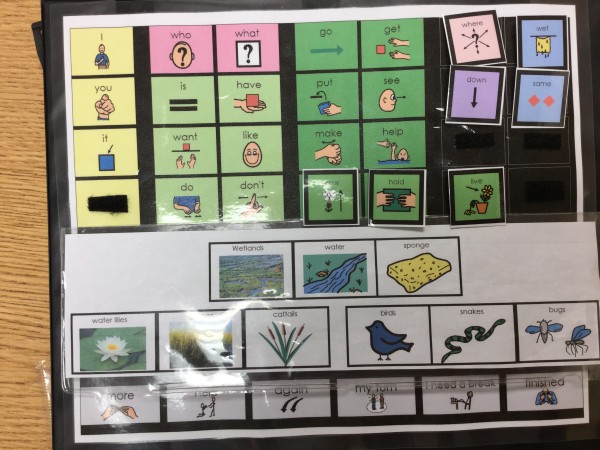
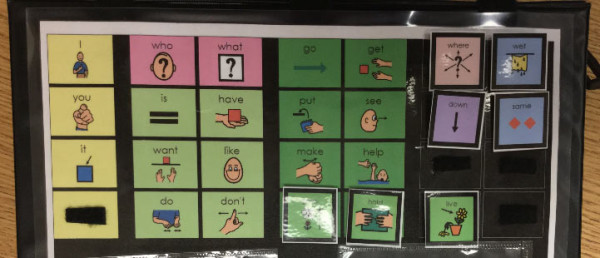
The black space in the middle has a Velcro strip for fringe vocabulary. I made a sleeve from the long edge of a plastic page protector (with Velcro on the back) to insert a strip of fringe words. 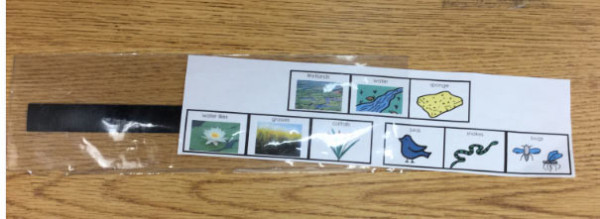
Alternatively, fringe words could be presented individually in plastic badge holders (with Velcro on the back). 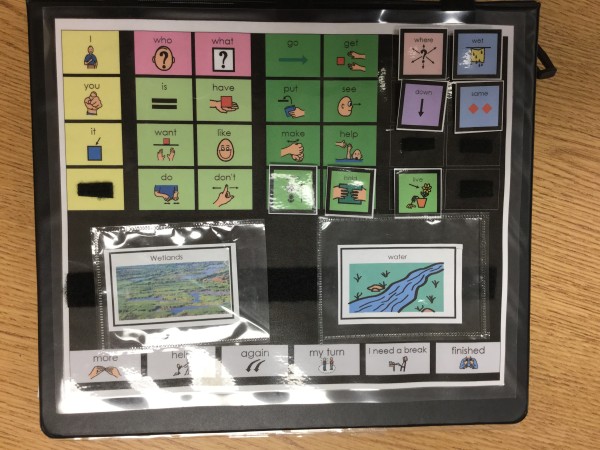
Also, note the vocabulary along the bottom edge of the board allows the student(s) some control over the interaction during individual or small group instruction/
The Black Board & large symbols: The example shown below relates to a chapter from Frog and Toad are Friends). Language of the Lesson included:
- Eat more cookies
- Stop eat(ing) cookies
- Put in box
- Put string around
- Put up high
- Birds eat
- Cookies all gone
The Black Board and large symbols enable teachers to visually model the language being used to define a salient concept, tell what is happening, or comment.
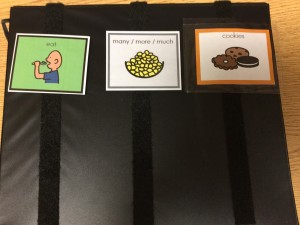
Symbols can be rearranged on the multiple rows of Velcro to create new meaning. In this story they “Eat more cookies” but try to “Stop eat(ing) cookies” so they don’t get sick. Though these are not the words used in the story, the gist of these statements are expressed repeatedly throughout the chapter.

I am finding that it works best to put all the symbols used during an activity in a pocket chart or on a hanging felt board, so I can see them all at once without rifling through the carpet pages to find the vocabulary I need.
Why We’re Excited!
This past semester, Classroom CORE Vocabulary books were created for each teacher and SLP at RCS. In the interest of full disclosure figuring out how to incorporate the Classroom CORE book is still in the experimental phase. But here are some of the things teachers have shared with me that excite them about using their books:
- Prep is simple (or should be once we get the hang of using it). Identify targeted concepts or ideas. Pull the core vocabulary needed to talk about those concepts. Arrange it meaningfully.
- Plastic sleeves and pockets are perfect for presenting fringe vocabulary. No more laminating. No more Velcro. Why did I think of this sooner?!
- Visually presenting vocabulary gives students and classroom staff a clear expectation of the vocabulary being targeted.
- While teachers often review fringe vocabulary at the beginning of a lesson, core vocabulary does not always receive equal attention, though it is an important step for students learning to use their AAC devices. This tool concretely identifies the core vocabulary to be used providing staff and students the opportunity to explore the various communication tools used by students to find and practice saying core and fringe words. This primes students to engage more readily in the lesson using vocabulary with which they are familiar, rather than hunting for it as it comes up in the lesson.
- Having a pre-made bank of high frequency vocabulary at my fingertips to modify materials “in the moment” is so beneficial for so many activities in our day.
- And this is my favorite….a Quote: “This is going to make me a better teacher. It’s going to make me focus on the language I use, and I ask my students to use. It’s going to make the language I use more meaningful.”
Say More, Use Core!
Assembling a Classroom CORE book is time-consuming, but adds great value to the teacher toolkit of those working with students who use AAC. As I learn more about how to incorporate these books in a variety of classroom activities, I’ll certainly share. If you create a Classroom CORE book, I would love to hear about where it takes you in your AAC adventures.
Download the Materials below
- Instructions for Assembly and Use (please read first for instructions on printing the templates):
- Templates
Filed under: PrAACtical Thinking
Tagged With: classroom, communication book, core vocabulary, Tabi Jones-Wohleber
This post was written by Carole Zangari
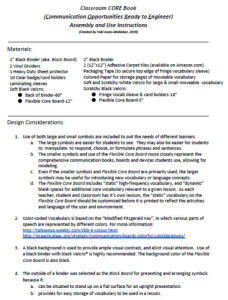


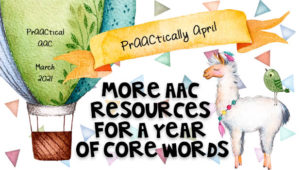
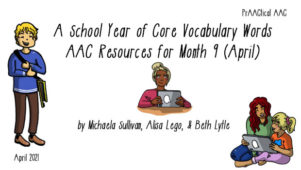

8 Comments
Thank you for sharing this wonderful resource and last month’s as well. Very generous and creative. You should share at MATN! Good to “see” you, neighbor!
Hi Sally and Tabi,
Tabi’s work is excellent! Tabi, thank you so much for sharing. Sally has a great idea about sharing at MATN!
Brilliant! Once you are familiar, the language is relatively seamless. Keep up the good work Tabi, you have a user friendly approach in creating “low tech” communication support, that actually works in the classroom.
This is awesome!! Thank you for sharing.
This is amazing. Thank you so much!!! This is exactly what we need to get more effective aided language stimulation happening in the classroom.
This looks amazing! And I cannot wait to try it, but I cannot find the instructions for how to set this up. Dropbox says they are missing.
I am also looking for the instructions file on how to set this up. Any chance you can find it and post an updated link?
I love it! Thank you so much! It’s just what we need to achieve more effective assisted language stimulation in the classroom.